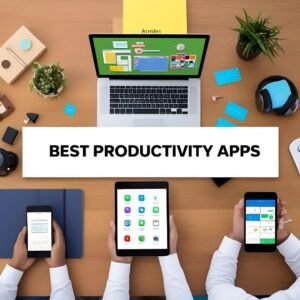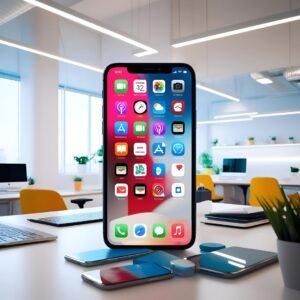Feeling overwhelmed by your endless to-do lists? You’re not alone. In our fast-paced digital world, the right productivity tools can be the difference between chaos and calm, between missed deadlines and mastered schedules. After extensively testing dozens of apps, I’ve curated the absolute best solutions that truly deliver on their promises – helping real people achieve more with less stress. You Will Know Top Best Productivity Apps
Why the Right Productivity Tools Matter More Than Ever

We’re all fighting the same battle against time. While we can’t add more hours to the day, we can dramatically improve how we use them. The best productivity apps act as force multipliers for your time and mental energy.
Best Productivity Apps
What makes these tools so powerful? They help in three crucial ways: First, they automate the repetitive tasks that drain your energy. Second, they create systems that keep your work and life organized without constant effort. Third, they protect your focus from the endless distractions of the digital world.
But here’s the catch – not every app works for every person. The key is matching the tool to your specific needs and work style. Are you a visual thinker who needs spatial organization? A list-maker who thrives on checking off tasks? Or maybe someone who needs strong boundaries against digital distractions? Understanding this will help you choose tools that feel helpful rather than burdensome.
The Best Productivity Apps for Every Need
Todoist: The Gold Standard for Task Management
When it comes to taming your to-do list, Todoist stands above the crowd. What makes it special isn’t just its clean interface or cross-platform availability, but how it adapts to your workflow rather than forcing you to adapt to it.

I’ve used Todoist to manage everything from simple grocery lists to complex work projects with multiple collaborators. The magic happens in how you can quickly capture tasks (with natural language input like “Email client every Friday at 3pm”), organize them into projects with custom labels and filters, and then actually get them done with helpful reminders.
The killer feature for me has been the integrations. When I star an important email in Gmail, it automatically becomes a Todoist task. When I schedule a meeting in Google Calendar, it appears in my task list. This seamless connectivity eliminates so much manual work and mental overhead.
Notion: Your Digital Workspace for Everything
If Todoist is your task manager, Notion is your entire digital workspace. It’s remarkably flexible – equally powerful for taking quick notes, managing complex projects, or even building a personal knowledge base.
What sets Notion apart is how it replaces multiple apps while still feeling intuitive. You can create simple checklists, detailed databases with multiple views (list, board, calendar), and even embed other tools like Google Docs or spreadsheets. I’ve gradually moved nearly all my work into Notion because having everything in one searchable place saves so much time.
For teams, Notion shines even brighter. Shared wikis keep everyone aligned, collaborative documents eliminate version confusion, and task boards make project progress visible at a glance. The learning curve pays off in spades as you build systems that work exactly how you think.
Freedom: Your Digital Focus Guardian
In a world of endless notifications and addictive apps, Freedom is the tool I recommend most urgently. It’s not about doing more – it’s about protecting your ability to do deep, meaningful work without constant interruption.

Freedom works by blocking distracting websites and apps across all your devices simultaneously. You can schedule focus sessions in advance or start them on demand when you need to concentrate. What makes it effective where other blockers fail is its psychological approach – once a session starts, even you can’t override it easily, removing the willpower battle.
After using Freedom for several months, I found my average focused work time increased from 45 minutes to nearly 2 hours per session. The cumulative effect on my productivity has been transformative. It’s particularly valuable for knowledge workers who need sustained concentration but work in distraction-filled digital environments.
Making the Most of Your Productivity System
The tools themselves are only part of the equation. To truly benefit, you need an intentional approach:
Start by identifying your biggest productivity leaks. Are you constantly forgetting tasks? Losing focus to social media? Spending too much time on email? Let these pain points guide your tool selection.
Implement new tools gradually. When I first discovered productivity apps, I made the mistake of trying to adopt too many at once. A better approach is to master one tool in your workflow before adding another.
Regularly review and refine. Every few weeks, assess what’s working and what isn’t. Maybe you need to adjust notification settings, create better templates, or explore additional integrations. The goal is continuous improvement, not perfection.
The Bottom Line
Productivity isn’t about doing more for the sake of it – it’s about creating space for what truly matters. The right tools, used thoughtfully, can help reclaim hours each week and reduce the mental load of managing our increasingly complex lives.
From my experience, the most impactful combination starts with a solid task manager (like Todoist), a flexible workspace (like Notion), and a focus protector (like Freedom). Beyond that, specialized tools can address specific needs, but these three form a powerful foundation.
Remember that no app is a magic solution. Real productivity comes from pairing good tools with intentional habits. But when you find the right combination? That’s when you’ll experience the game-changing difference of working smarter, not harder.
What productivity challenges are you currently facing? I’d love to hear which apps have worked (or haven’t worked) for you – your experience might help others find their perfect productivity solution.

